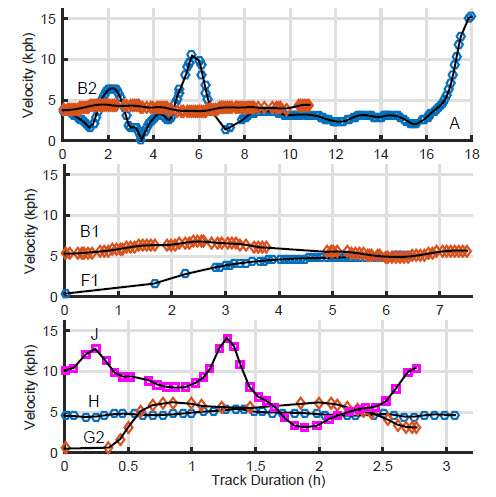Call of the wild: acoustic Localization of Bryde's whale calls yields insights into their behavior

Researchers at the Space and Naval Warfare Systems Center Pacific (SSC Pacific) have recorded a Bryde's whale (Balaenoptera edeni) call for the first time from the Hawaiian Islands, which appears to be similar to a Bryde's whale call produced throughout the Pacific Ocean. The team was able to track the whales based on acoustic localization of their calls, and found that Bryde's whales travel faster than previously thought, and in a parallel pattern that suggests they're traveling in spaced groups, possibly using acoustic calls to maintain their formation.
An article in The Journal of the Acoustical Society of America details the findings made off the west coast of the island of Kauai in the Hawaiian Islands. Bryde's whales are typically 40 to 50 feet in length, and are the only baleen whale that is distributed tropically and sub-tropically year-round. The calls, recorded over a three-month period, were similar to those described for Bryde's whales in other regions, but with notably different spectral characteristics and intercall intervals, or time between calls.
Using the time difference of arrival of the acoustic recordings of 17 whale tracks, scientists from SSC Pacific and the Scripps Institution of Oceanography were able to show, for the first time, that Bryde's whales were traveling in groups, with individual whales spaced 5 to 20 kilometers apart.
When whales were in close proximity, the time intervals between their calls became synchronous, but when one whale veered off course and stopped calling, the other increased the amount of time between its calls.
This group behavior has not been documented before, and indicates that these vocal calls may be used as a way to maintain a certain spacing while traveling. Further study is required to learn how they move and interact as a group, and why. This current research is focused on establishing a baseline of behavior of Bryde's whales, which is difficult to do given their deep water transiting habitat.
Additionally, the research found that Bryde's whales move faster than previously thought. In prior studies, Bryde's whales were found to travel at mean speeds of 2.9 to 5.5 kilometers-per-hour (kph), but the SSC Pacific team found that the whales tracked in Hawaii traveled at mean speeds of 2 to 11 kph, with a mean of 5.9 kph. Further research and acoustic data is necessary to determine if this is a season- or habitat-based pattern.
Tyler Helble, a maritime surveillance engineer at SSC Pacific with a Ph.D. from the Scripps Institution of Oceanography and one of the authors of the study, said that the Navy and SSC Pacific are uniquely positioned to conduct this type of groundbreaking research.
"We have a unique position to monitor whales in this region, where the ocean is drastically under-sampled," Helble said. "This work is important because we can actually track multiple animals at the same time using acoustics, to see how their vocal behavior is correlated with their movement patterns. I think we have an opportunity to show how the Navy demonstrates good stewardship by using our assets for the good of the greater scientific community."
SSC Pacific is a Navy research and development lab tasked with ensuring Information Warfare superiority for the warfighter, and providing the U.S. Navy and military with essential capabilities in the areas of command and control, communications, computers, intelligence, surveillance, and reconnaissance (C4ISR).
More information: Tyler A. Helble et al, Swim track kinematics and calling behavior attributed to Bryde's whales on the Navy's Pacific Missile Range Facility, The Journal of the Acoustical Society of America (2016). DOI: 10.1121/1.4967754
Journal information: Journal of the Acoustical Society of America
Provided by Space and Naval Warfare Systems Center



















